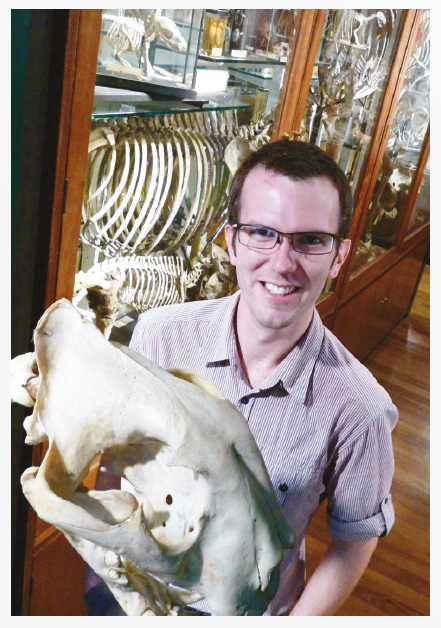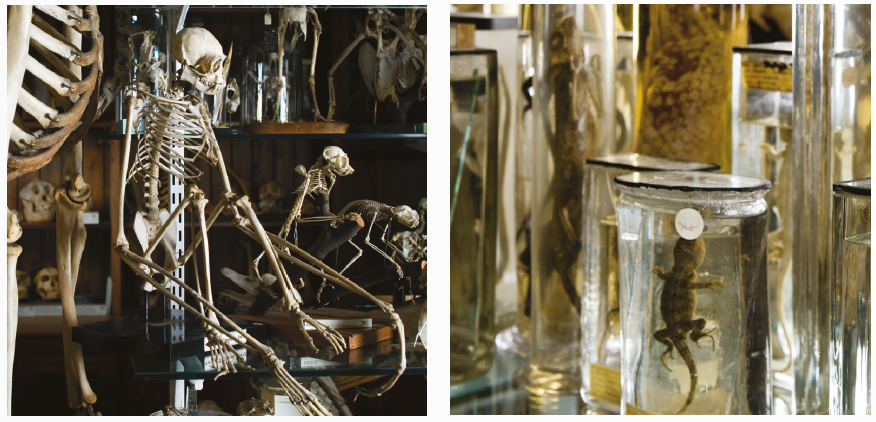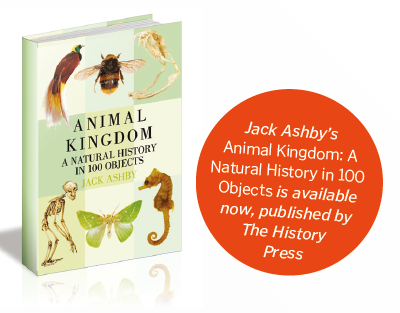Extinct zebras and poisonous platypus: How it Works talks weird evolution with zoologist Jack Ashby
How It Works’ Charlie Evans speaks to the renowned zoologist Jack Ashby about his career

Author and zoologist Jack Ashby holding a specimen at the museum
Jack Ashby has worked as the Grant Museum manager since 2011, having graduated from Cambridge University with a zoology degree and originally joined the museum as the learning and access manager. In his new book, Animal Kingdom, he compiles a selection of 100 natural history specimens, telling their 100 stories: from the incredible feats of evolution displayed in insect mimicry —where non-poisonous butterflies mimic their poisonous counterparts to protect themselves from predation — to the mysterious purpose of the narwhal’s tusk.
The book explores 600 million years of natural history, with examples from across the animal kingdom, including the duck-billed platypus, electric eel and brain-controlling parasitic fungi. We spoke with him about his love for zoology, the museum he manages and his new book.
What is The Grant Museum of Zoology, and what do you do there?
My job is to find interesting ways to engage both the public and universities with the museum, as well as trying to bring universities’ research into the museum and engage the public by using objects. We house approximately 68,000 specimens; it’s relatively small, but we have a huge amount on display. We have more specimens on display than the Natural History Museum, at least of animals — we don’t have minerals or plants. The museum dates back to the 1820s; it’s one of the earliest natural history museums in the country. It still looks reasonably traditional but that’s quite deliberate. It covers the whole of the animal kingdom, all the palaeontological time, the whole world. What’s nice, what’s different, is that there are lots of skeletons and skulls in jars without too much taxidermy, because it’s more of a teaching collection. Taxidermy isn’t that useful for teaching. It was initially set up to teach the fi rst courses in zoology and comparative anatomy. Robert Grant was one of the leading comparative anatomists, of the 19th century, and the first 10,000 or so objects here are his, so [there is] definitely a comparative anatomy focus across the museum.
Which specimen would you say has the most educational value?
That’s a tricky question, because measuring educational value is pretty subjective. Our rarest specimen is a quagga, an extinct species of a not-very-striking zebra that became extinct in 1883. We have one of only seven skeletons in the world and the only one on display in the UK. It’s also pretty cool as it was actually missing one of its legs, so we CT scanned the surviving leg, flipped the data and 3D printed a replacement leg. We’ve also got the only fluid-preserved adult thylacine [an extinct carnivorous marsupial] in the world on display.
Do you have a favourite specimen from the museum that you’ve included in your book?
I do. My particular interest is the zoology of Australian mammals and their ecology and evolution, and so platypuses are very much my favourite animal. So I have used that as object number one, which is completely out of order from the rest of the book, just because it’s my favourite specimen.

What do you like about the platypus?
They are an evolutionary biologist’s dream because the platypus often gets inaccurately described as a primitive animal. They have distinctive features inherited from their reptilian ancestors — they famously lay eggs and walk with bent elbows and knees, akin to a crocodile. But on top of their relatively primitive frame they have some of the most bizarre yet advanced characteristics of any mammal. Did you know they are among the only mammals that can detect electricity? A platypus’ bill can detect electrical impulses generated by the muscular movement of their prey underwater, and the male platypus is one of just a few venomous mammals. Evolution has taken this animal, which has been around for approximately 120 million years, and without changing much of its ancient features, added some of the most advanced characteristics of any mammal. They also look pretty weird, huh?
How are the samples in the museum preserved?
The most common three methods of preservation are taking the bones out, taxidermy skins and fluid preservation, and to an extent they stay pretty much the same; preparing bones hasn’t changed a great deal. The only real thing that has come up in the last few decades is how to speed things up a bit — large animals traditionally just get buried and that still happens today. People will still bury whales to prepare the whale bones, and there are stories from both University College London and the Natural History Museum that there were whales buried, still buried, in the gardens that people have forgotten about. [After being buried] you can use warm water or wet sand. These days you can use biological washing powder; the enzymes in it will speed up the process by chewing on the biological bits of soft tissue. You can also use live carpet beetles. One of the biggest threats to museum collections is being eaten by a pest, so these are a problem for museums, but actually they’ve now been used as helpers by locking them in tanks with small carcasses, then the beetles will strip the flesh from the bone. In terms of fluid preservation it is something people are learning about because you don’t know if it works until maybe decades later. Different fluids come in and out of fashion.
How do you preserve a sample in fluid?
There are two stages to preservation. First you have to fix the specimen — this halts the process of decomposition by binding the organic molecules inside each cell. That’s commonly done with formalin, which is dilute formaldehyde gas in solution. It’s a really nasty carcinogenic [cancer-causing] chemical, so not something you want to be around much. Fixing is done inside the animal, but the second step is preserving, which is basically pickling to maintain [the specimen’s] structure in the longterm. Formalin was used as a preservative and can still be used, but now we more commonly use industrially methylated spirits.

Some of the specimens on display at the Grant Museum
Have you ever had a problem with your specimens that have gone rotten or been dropped?
It happens rarely, but if something has been there for a very long time and all of the alcohol has evaporated, the specimens will start to rot. Sometimes what happens — particularly in university museums where a collection has kind of evolved organically from a lot of people’s research specimens — people would have been collecting something for their research in the 1950s and stuck it in a bucket waiting for it to be properly preserved. But rather than fixing it they might have just put it in a bath of alcohol, and then we’ll open it 70 years later and it’s rotten. Rarely do disasters happen, but there are occasional times where fixatives don’t work. You’ll find the specimen has rotted away and you might be able to salvage a skeleton, but otherwise you’ll just have to throw it away.
How did you select just 100 specimens to talk about in your book from a total of 68,000 at the museum?
It was difficult. Every object tells thousands of stories. There is some real bias about the animals we hear about on TV, in books and museums. We mostly hear about the big, dramatic animals, but actually most animals are invertebrates. They just don’t get a lot of coverage. So the first section is about diversity. It just goes through most of the ways of being an animal, most of the major groupings of animals. I didn’t do all of them because quite a lot of them are worms, and there are not a lot of different things to say about the really small groups of worms. [Throughout the book] I wanted to tell what I found to be the most interesting aspects of natural history. So what are the weirdest stories in terms of natural selection, sexual selection, competition, and adaptation. I really thought about which animals or specimens would really show those big stories, and then to finish with I wanted to get into what makes museums a bit weird. They’re not sterile or natural or even necessarily scientific places, but they’re human inventions and they’re products of their own history; the biases of human nature and human politics, which affects how people understand animals. 
For more science and technology articles, pick up the latest copy of How It Works from all good retailers or from our website now. If you have a tablet or smartphone, you can also download the digital version onto your iOS or Android device. To make sure you never miss an issue of How It Works magazine, subscribe today!





